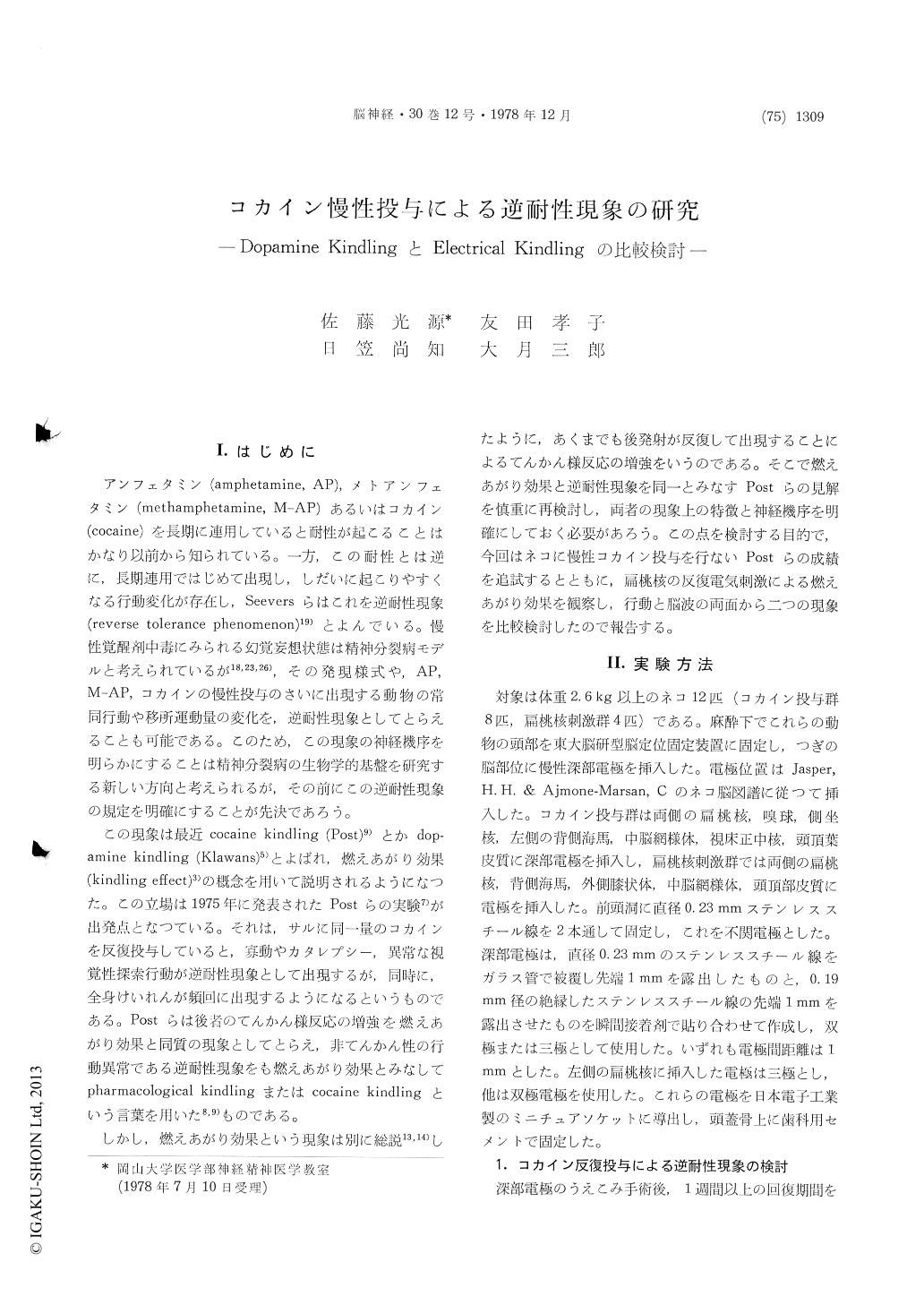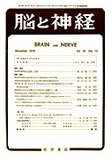Japanese
English
- 有料閲覧
- Abstract 文献概要
- 1ページ目 Look Inside
Ⅰ.はじめに
アンフェタミン(amphetamine,AP),メトアンフェタミン(methamphetamine,M-AP)あるいはコカイン(cocaine)を長期に連用していると耐性が起こることはかなり以前から知られている。一方,この耐性とは逆に,長期連用ではじめて出現し,しだいに起こりやすくなる行動変化が存在し,Seeversらはこれを逆耐性現象(reverse tolerance phenomenon)19)とよんでいる。慢性覚醒剤中毒にみられる幻覚妄想状態は精神分裂病モデルと考えられているが18,23,26),その発現様式や,AP,M-AP,コカインの慢性投与のさいに出現する動物の常同行動や移所運動量の変化を,逆耐性現象としてとらえることも可能である。このため,この現象の神経機序を明らかにすることは精神分裂病の生物学的基盤を研究する新しい方向と考えられるが,その前にこの逆耐性現象の規定を明確にすることが先決であろう。
この現象は最近cocaine kindling (Post)9)とかdop—amine kindling (Klawans)5)とよばれ,燃えあがり効果(kindling effect)3)の概念を用いて説明されるようになつた。この立場は1975年に発表されたPostらの実験7)が出発点となつている。それは,サルに同一量のコカインを反復投与していると,寡動やカタレプシー,異常な視覚性探索行動が逆耐性現象として出現するが,同時に,全身けいれんが頻回に出現するようになるというものである。Postらは後者のてんかん様反応の増強を燃えあがり効果と同質の現象としてとらえ,非てんかん性の行動異常である逆耐性現象をも燃えあがり効果とみなしてpharmacological kindlingまたはcocaine kindling という言葉を用いた8,9)ものである。
Progressive and long-term increase of sensitivity to cocaine and amphetamine after the chronic administration has been called reverse tolerance phenomenon' (Seevers & Deneau, 1963) and con-sidered to be an important concept for studying the biological mecanisms of canine- or amphetamine-psychosis recently. Post et al. (1975) and Klawans (1977) described the reverse tolerance phenomenon as a phenomenon analogous to the electrical kindling phenomenon originally described by Goddard et al. 1969), and used the term 'cocaine kindling' or 'dopamine kindling' instead of the 'reverse tolerance phenomenon '. However, the neuromechanisms underlying both the dopamine and the electrical kindling has not yet been clear. In order to elucidate this problem, cocaine-induced reverse tolerance phenomenon and electrical amygdaloid kinding in cats were compared in this study. Behavioral and electroencephalographic observations were made during the daily administration of cocaine and electrical amygdaloid stimulation in the different group of cats. Following results were obtained; 1) the common characteristic finding of both phenomenon was thas sensitization of response appeared only after the repeated administration and was long-lasting for more than three months, 2) in the case of cocaine-induced reverse tolerancephenomenon, sensitized response was limited in nonepileptic behavioral or electrographic response just as stereotyped behavior and increase of slow EEG activity in the olfactory bulb and/or globus pallidus. On the other hand, convulsive response was intensified along with a prolongation of after-discharge duration and appearance of interictal discharge in the stimulated and unstimulated brain structures in the electrical amygdaloid kindling. No change in nonepileptic behavioral response was found in this group, 3) cocaine-induced reverse tolerance phenomenon appeared with increased sensitivity to apomorphine, while the electrical kindling was suppressed markedly by the pre-treatment of chronic cocaine administration and facilitated by the haloperidol treatment as we have reported previously. Together with these findings, it is suggested that hypersensitivity of dopamine receptor may play an important role for inducing cocaine-induced reverse tolerance phenomenon but play an inhibitory role for establishing supposed transsynaptic changes underlying the electrical kindling. It is concluded that the reverse tolerance and electrical kindling might be the phenomenon with the same phenomenologic characteristic but depending upon the different, rather antagonistic underlying neurobiological base.

Copyright © 1978, Igaku-Shoin Ltd. All rights reserved.


